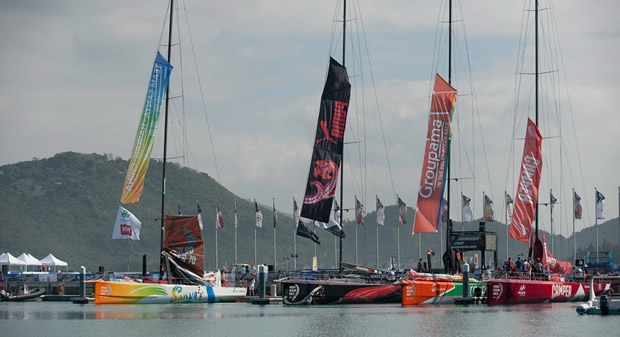
Gale on the South China Sea
Gale force conditions bringing with them the potential for more breakages will be on the minds of all six teams as they gear up for a return to competitive action with the Sanya Haitang Bay In-Port Race this Saturday, 18 February, followed the next day by the start of the Volvo Ocean Race's fourth leg from Sanya, China to Auckland, New Zealand.
Saturday’s in-port starts at 1400 local time (0600 UTC) with near perfect winds and flat seas forecast for the 60 minute inshore course.
The forecast for Sunday’s Leg 4 start are in stark contrast with gale force monsoon winds combined with a rough sea state likely to give the fleet its toughest test to date as they funnel their way between Taiwan and the Philippine island of Luzon en route to New Zealand.
Volvo Ocean Race meteorologist Gonzalo Infante is forecasting a monsoon to develop to the north of Taiwan resulting in northeasterly winds of 35-40 knots across the South China Sea over the weekend.
Infante says Sanya Bay’s protection from the northeast monsoon by mountains should mean conditions for the in-port race will be perfect with moderate winds and flat seas. But offshore it will be a very different story when the fleet sets off the following day: "Now only a very small area in the centre of the South China Sea is affected by big waves – from six to eight metres. However, as we get closer to the start date, the affected area will grow until by Saturday the whole South China Sea will be affected by this sea state.”
Race leaders Team Telefónica opted to miss today’s practice race to change to their spare rig after a routine check revealed a problem. But the Spanish race leader’s decision ultimately cost them little in lost training time when light winds forced the abandonment of the practice race.
Skipper Iker Martínez said the team were being cautious because of the forecast of strong winds and the fact that two boats lost their masts during Leg 1: “We want to be super safe. We found something that we didn’t like much so we’ve decided to replace the rigging for the next leg, and we have a spare rig here that we’ve used already and we’re very confident with.”
Removing the mast, changing the rigging, using a spare rig in its place to be out sailing by tomorrow and to test that everything is in the right place and ready for Saturday's in-port race is the plan for the Spanish team. “It's a rig which already has a few miles on it, but a lot fewer than the rig we've had up until now which has done all of the racing so far," says Martinez. "The spares we've got have all been used so that we are sure they work well, and that's why we are not at all afraid about making the change. It's safer and that's why we are doing it. It's a spare rig that we've used a fair bit before the race, so we have no hesitations."
The shore crew and boat crew have been working since the morning in Sanya (the early hours of the morning in Spain) to carry out this operation: replacing the rigging and putting the mast back in place. “It is a pretty straightforward transfer and we think that by doing it we'll be avoiding any potential problems. It's likely that the one we had up was fine, and that we may have been able to complete the leg without an issue but we always try to check everything as thoroughly as possible and we try to be very careful. It's better to be on the safe side, especially with a leg as tough as the one we have ahead of us may be”, said Iker.
Going into Saturday's in-port, Team Telefónica hold a 15-point lead over the Chris Nicholson and Stu Bannatyne co-skippered Camper with Emirates Team New Zealand.
Camper has yet to score a victory, but, according to team Managing Director Grant Dalton, a strong performance on Saturday is vital if they are to close the gap on Telefónica.
“First of all, we have to stop bleeding points inshore,” Dalton said. “We’ve bled enough offshore, we have to stop bleeding them inshore. If Telefónica keep on going the way they are, we’re not going to beat them. You don’t have to be a rocket scientist to work that out.”
Dalton, who won the race himself in 1981-82 and 1993-94, said the fourth leg to Auckland, which the Spanish-sponsored team counts as one of two bases, was also providing motivation: “Auckland is important for two reasons. It’s important because there’s so much history of titanic struggles into Auckland - the last three races I did we were never more than a couple of minutes apart the whole way – and it’s important for some of the guys because they’re coming home. It’s both pressure and motivation. You’re motivated to sit on the rail for the last two and a half days if you have to.”










Latest Comments
Add a comment - Members log in